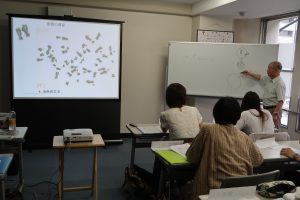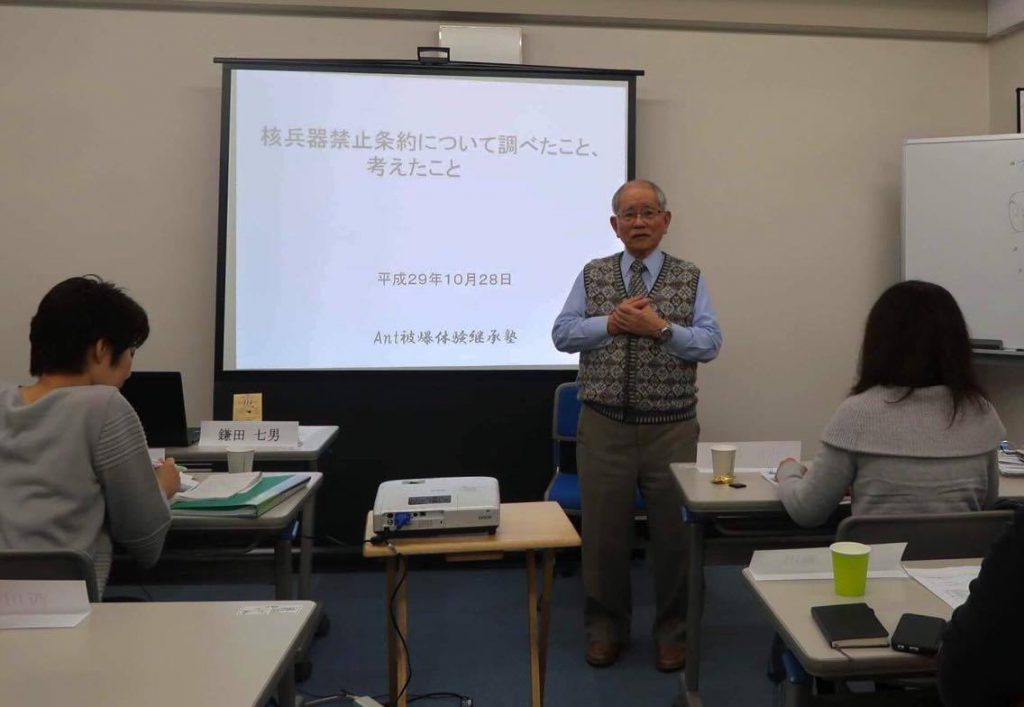One of ANT-Hiroshima’s newest projects is the Hibakusha Study Course, a 12-session class that took place from April 2017 to March 2018. Former Hiroshima Hibakusha Relief Foundation Director and Hiroshima University Professor Emeritus Dr. Nanao Kamada, a specialist in the biological effects of radiation, collaborated with ANT-Hiroshima to teach the course.
The Hibakusha Study Course aims to give its participants extensive knowledge of the effects of radiation on people, with a focus on hibakusha experiences both in Hiroshima and Nagasaki and globally. The second half of the course also delved into local and global disarmament activities. The ability to draw upon such knowledge — to combine facts with personal stories — can be relevant to anyone, but it is particularly essential for those working for nuclear abolition. The course connects scientific and historical facts with the ongoing dangers of nuclear weapons and nuclear energy, bridging past and present. Much of its content is the result of years of research by dedicated individuals in ongoing cooperation with hibakusha.

The Hibakusha Study Course is the first project of its kind for ANT-Hiroshima. Staff, volunteers, and partners keenly felt the urgency of the aging hibakusha community and decided to make concrete preparations for the day when Hiroshima’s and Nagasaki’s hibakusha are no longer with us. To course participants and organizers, gaining a detailed factual understanding of nuclear issues is one way to make the realities of Hiroshima and Nagasaki their own story.
Three of the participants work or are currently being trained as official memory keepers of Hiroshima’s experience; they’re taking part in ANT-Hiroshima’s course in addition to the three years of training they receive from Hiroshima City. Other participants include a Buddhist priest, a teacher, a nurse, a university student, and others who have been involved in ANT-Hiroshima’s activities. ANT-Hiroshima capped eligible participants’ age at 60, as the course is aimed at people without firsthand experience of its subject matter.

The group became fast friends who learned from each other over the year-long course. Along with a lecture from Dr. Kamada, each session included time for participants to ask questions, reflect on previous sessions, and share their opinions; members’ diverse backgrounds and experiences contributed to lively discussions with a range of viewpoints. And in their own ways, everyone put what they learned into action outside the course.
The first two sessions focused on the effects of radiation on people. Dr. Kamada introduced major research in the field, then guided participants through an activity in which they cut out 46 paper chromosomes and arranged them by size. Chromosomes’ abnormality can be examined to estimate the amount of radiation they have been exposed to, although in reality one needs to examine about 100 chromosomes before abnormality becomes apparent. The group also got hands-on experience using a scintillation detector, borrowed from the Hiroshima International Council for Health Care of the Radiation-exposed (HICARE). Particpants discussed differences between victims of atomic bombings and victims of radiation exposure through other means, such as nuclear accidents or nuclear testing.
The third and fourth sessions covered data collection methods and differences between visible effects of the atomic bombings and the initially invisible effects of exposure to radiation, respectively. During the latter session, discussion delved into how government policies toward visible and invisible effects vary.

The course’s fifth session, held in late August, included an extra assignment for participants to write a reflection about their thoughts on the anniversaries of the bombings of Hiroshima and Nagasaki that year. Along with sharing their reflections, participants analyzed the messages from representatives of Hiroshima and Nagasaki during that year’s memorial ceremonies.
The seventh session focused on the Treaty on the Non-Proliferation of Nuclear Weapons (NPT) and 2017’s Treaty on the Prohibition of Nuclear Weapons (TPNW). Participants studied the historical steps that led up to the creation of both treaties and Japan’s position therein, including its refusal to participate in talks for or sign the latter. In a similar vein, the eighth session focused on two organizations that won Nobel Peace Prizes for their work advocating for nuclear disarmament: International Physicians for the Prevention of Nuclear War (IPPNW) and the International Campaign to Abolish Nuclear Weapons (ICAN).
Following sessions focused on nuclear power and nuclear accidents, as well as the psychological effects of experiencing an atomic bombing or being exposed to radiation. The second to last session covered how Japan is currently reprocessing its nuclear waste. Discussion focused on not only the feasibility of the government’s current plan (or perhaps lack thereof), but also how average citizens can make their voices heard on these issues.
The year-long course came to an end with a final session spent reflecting on how participants’ opinions and attitudes have been changed by what they learned.

ANT-Hiroshima is grateful to Dr. Kamada for offering his time and expertise throughout the course. He unfailingly read all of the participants’ written work and would follow up in subsequent sessions if he realized there were points the class hadn’t completely understood.
After reflecting on the 2017-18 course with Dr. Kamada, ANT-Hiroshima staff decided to hold a second cycle for 2018-19. This year’s course will streamline its contents to cover roughly the same amount of material in six sessions instead of 12. Applicants can request specific topics on the course application form. The participant age limit is now capped at 50, and ANT-Hiroshima is specifically hoping that young people, teachers, and individuals working in media apply.
The application deadline for the 2018-19 course is May 12 — so please contact ANT-Hiroshima if you are interested!

